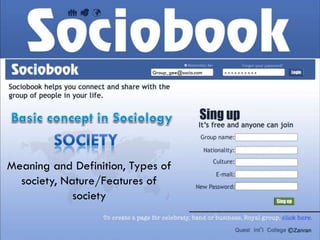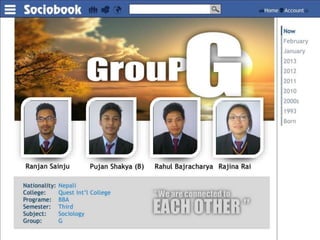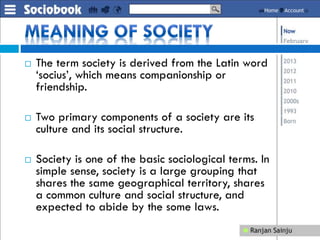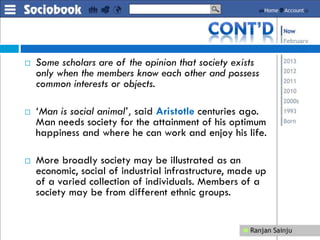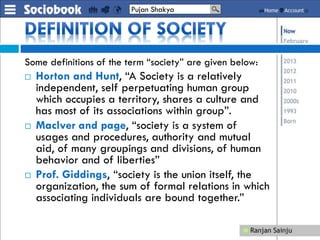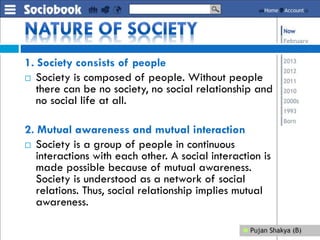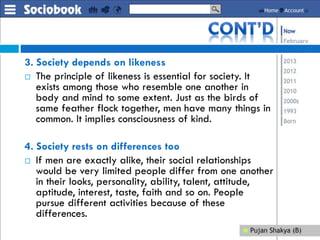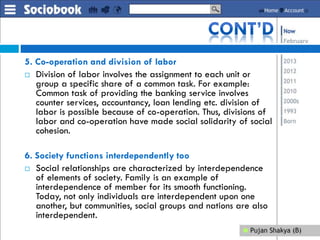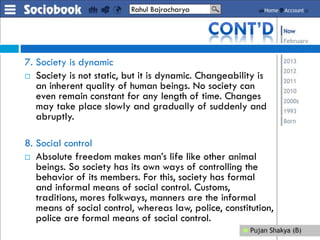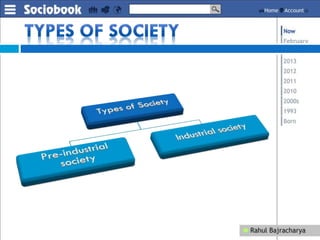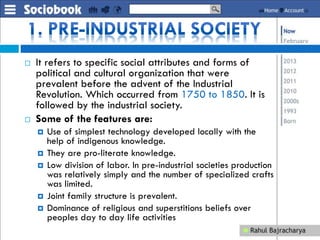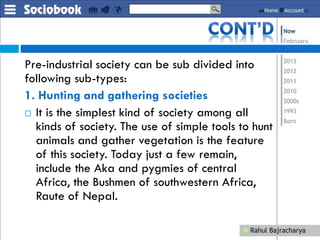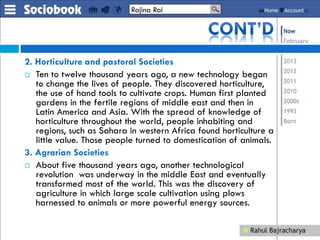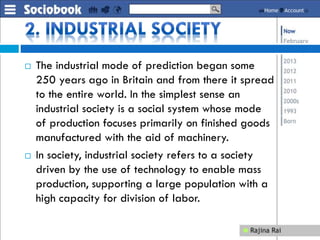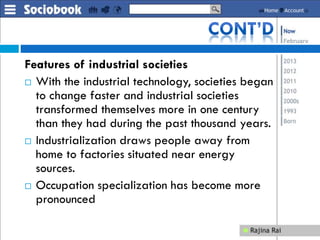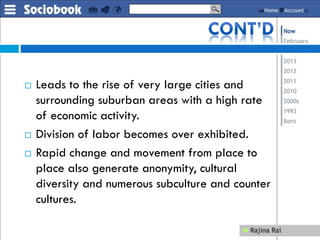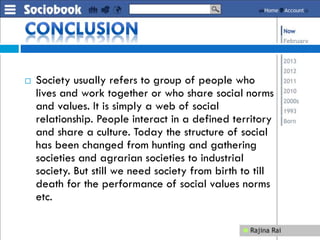Basic concept in sociology - Society
- 1. Group_gee@socio.com * * * * * * * * * * Meaning and Definition, Types of society, Nature/Features of society
- 3. The term society is derived from the Latin word ‘socius’, which means companionship or friendship. Two primary components of a society are its culture and its social structure. Society is one of the basic sociological terms. In simple sense, society is a large grouping that shares the same geographical territory, shares a common culture and social structure, and expected to abide by the some laws.
- 4. Some scholars are of the opinion that society exists only when the members know each other and possess common interests or objects. ‘Man is social animal’, said Aristotle centuries ago. Man needs society for the attainment of his optimum happiness and where he can work and enjoy his life. More broadly society may be illustrated as an economic, social of industrial infrastructure, made up of a varied collection of individuals. Members of a society may be from different ethnic groups.
- 5. Some definitions of the term “society” are given below: Horton and Hunt, “A Society is a relatively independent, self perpetuating human group which occupies a territory, shares a culture and has most of its associations within group”. Maclver and page, “society is a system of usages and procedures, authority and mutual aid, of many groupings and divisions, of human behavior and of liberties” Prof. Giddings, “society is the union itself, the organization, the sum of formal relations in which associating individuals are bound together.” Pujan Shakya
- 6. 1. Society consists of people Society is composed of people. Without people there can be no society, no social relationship and no social life at all. 2. Mutual awareness and mutual interaction Society is a group of people in continuous interactions with each other. A social interaction is made possible because of mutual awareness. Society is understood as a network of social relations. Thus, social relationship implies mutual awareness.
- 7. 3. Society depends on likeness The principle of likeness is essential for society. It exists among those who resemble one another in body and mind to some extent. Just as the birds of same feather flock together, men have many things in common. It implies consciousness of kind. 4. Society rests on differences too If men are exactly alike, their social relationships would be very limited people differ from one another in their looks, personality, ability, talent, attitude, aptitude, interest, taste, faith and so on. People pursue different activities because of these differences.
- 8. 5. Co-operation and division of labor Division of labor involves the assignment to each unit or group a specific share of a common task. For example: Common task of providing the banking service involves counter services, accountancy, loan lending etc. division of labor is possible because of co-operation. Thus, divisions of labor and co-operation have made social solidarity of social cohesion. 6. Society functions interdependently too Social relationships are characterized by interdependence of elements of society. Family is an example of interdependence of member for its smooth functioning. Today, not only individuals are interdependent upon one another, but communities, social groups and nations are also interdependent.
- 9. 7. Society is dynamic Society is not static, but it is dynamic. Changeability is an inherent quality of human beings. No society can even remain constant for any length of time. Changes may take place slowly and gradually of suddenly and abruptly. 8. Social control Absolute freedom makes man’s life like other animal beings. So society has its own ways of controlling the behavior of its members. For this, society has formal and informal means of social control. Customs, traditions, mores folkways, manners are the informal means of social control, whereas law, police, constitution, police are formal means of social control. Rahul Bajracharya
- 11. It refers to specific social attributes and forms of political and cultural organization that were prevalent before the advent of the Industrial Revolution. Which occurred from 1750 to 1850. It is followed by the industrial society. Some of the features are: Use of simplest technology developed locally with the help of indigenous knowledge. They are pro-literate knowledge. Low division of labor. In pre-industrial societies production was relatively simply and the number of specialized crafts was limited. Joint family structure is prevalent. Dominance of religious and superstitions beliefs over peoples day to day life activities
- 12. Pre-industrial society can be sub divided into following sub-types: 1. Hunting and gathering societies It is the simplest kind of society among all kinds of society. The use of simple tools to hunt animals and gather vegetation is the feature of this society. Today just a few remain, include the Aka and pygmies of central Africa, the Bushmen of southwestern Africa, Raute of Nepal.
- 13. 2. Horticulture and pastoral Societies Ten to twelve thousand years ago, a new technology began to change the lives of people. They discovered horticulture, the use of hand tools to cultivate crops. Human first planted gardens in the fertile regions of middle east and then in Latin America and Asia. With the spread of knowledge of horticulture throughout the world, people inhabiting and regions, such as Sahara in western Africa found horticulture a little value. Those people turned to domestication of animals. 3. Agrarian Societies About five thousand years ago, another technological revolution was underway in the middle East and eventually transformed most of the world. This was the discovery of agriculture in which large scale cultivation using plows harnessed to animals or more powerful energy sources. Rajina Rai
- 14. The industrial mode of prediction began some 250 years ago in Britain and from there it spread to the entire world. In the simplest sense an industrial society is a social system whose mode of production focuses primarily on finished goods manufactured with the aid of machinery. In society, industrial society refers to a society driven by the use of technology to enable mass production, supporting a large population with a high capacity for division of labor.
- 15. Features of industrial societies With the industrial technology, societies began to change faster and industrial societies transformed themselves more in one century than they had during the past thousand years. Industrialization draws people away from home to factories situated near energy sources. Occupation specialization has become more pronounced
- 16. Leads to the rise of very large cities and surrounding suburban areas with a high rate of economic activity. Division of labor becomes over exhibited. Rapid change and movement from place to place also generate anonymity, cultural diversity and numerous subculture and counter cultures.
- 17. Society usually refers to group of people who lives and work together or who share social norms and values. It is simply a web of social relationship. People interact in a defined territory and share a culture. Today the structure of social has been changed from hunting and gathering societies and agrarian societies to industrial society. But still we need society from birth to till death for the performance of social values norms etc.

